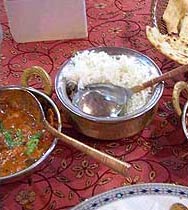Indian Food
 Indian Food Delicacies With The Wormth of Festivals
Indian Food Delicacies With The Wormth of Festivals
There's a festival to every working day in India. Two things which come as a package deal with every festival are new clothes and – you guessed it – food. Almost every festival in India has a special dish, or dishes, as the case may be, associated with it. Traditionally famous Indian food is cooked at home, and in huge amounts because all festivals are open houses in India.
Here's just a taste of what you can expect:
Pongal, Literally meaning 'boiling over', Pongal is perhaps the most important Tamilian festival in India. It is, basically, a harvest festival and is celebrated to thank the sun god and the god of rain, Indra, for a good paddy crop. The actual day of Pongal is January 14, although the day before it is also celebrated. Traditionally, Pongal is celebrated over three-four days; however no one does that any more and in cities everyone restricts the festivities to two days.
Different food dishes are associated with the days of Pongal. On the first day rice, being central to the south Indian cuisine and also to the festival itself, is cooked. There is also vadai (fried chickpea patties) and poli (sweet pancake). On this day only the members of the family eat together.
On the second day, the day of the celebration itself, food is cooked only by the women of the house and not by servants. There are two special foods for this day, venpongal (mixture of steamed rice and dal) which is salty, and chakkaraipongol (jaggery and ghee mixed to steamed dal and rice) that is sweet. Apart from these, rice in various forms – boiled, fried, sweet and salty – is also eaten. Sugarcane is very much a part of the festival and is eaten all the time in Pongal.
Holi Festival
For the first timer, Holi, the festival of colors, can be a little dizzying experience. The scene is a total splash of colors.
Clutches of men, women, boys and girls walk, drive or dance around together, their features and clothes almost totally obliterated by all the hues that one can think of.
All social barriers break down in Holi and no one thinks anything of rubbing gulaal (powdered color) and other liquid colors of all hues on total strangers; and that includes you.
The single most popular thing associated with Holi is bhang, an alcoholic drink which is mixed in almost every household and flavored with dried fruits and rosewater. Bhang is not only drunk by the people of the house, but is also offered to all the visitors. Along with it come various famous Indian foodstuffs which are made especially in Holi. These are kanji-ke-bare (thin lentil patties), papri (small pooris) and gujjias (sweet dumplings stuffed with khoya and dried fruits).
Durga Puja
Durga Puja is the big Bengali festival, and is celebrated with great fervor and pomp all over India for over a week. This is the festival of the mother goddess, Shakti. Preparations for Durga Puja begin almost a month in advance; clothes are bought, puja pandals (huge tents) are put up, arti (ritual prayer) competitions are prepared for and, most importantly, food for the puja is thought out.
Bhog (ritual offering) is traditionally served out every day on the week of the puja, which is a proper meal. This includes moong dal khichri (mixture of dal and rice, said to be very nutritious), charchari (mixture of various vegetables), payesh (kheer) and a tomato chutney which only Bengalis know how to make best.
Diwali
Falling soon after Durga Puja, the next big all-India thing after Holi is Diwali. Diwali is often described as the festival of lights, and one can appreciate how good this description is only when you're here in India on the day, or rather night. Even the poorest household manages to put together at least a few small diyas (lamps) to light up the house. A walk down the streets of the gleaming cities is well recommended during Diwali.
Sweets are everywhere and always in Diwali, and of all kinds, shapes and sizes. Pride is taken in serving sweets different from what is being served in other houses. Kids eat toys made out of candy, try these only if you have a really sweet tooth. The other things cooked as food are rice, whole green lentils and mandhi (a halwa; sweet paste).
Id
Id comes twice in the year and almost inseparable from food – considering that it is celebrated to mark the end of the Muslim month of fasting. Id celebrations are sumptuous feasting days when the women of house work for hours preparing rich delicacies which are served to the members of the family and neighbors. These are then laid out in the common dining area for any visitor to come and sample.
The first Id to come each year is the Id-ul-Fitr, which is also called the sewaiyan Id. The reason is that delicious, syrupy semolina (sewaiyan) is cooked flavored with saffron and dried fruits. A complementary dish is the super-sweet kheer korma, which is thin sewaiyan cooked in thickened milk and flavored with nuts and saffron.
The other is the Bakr-Id, when a goat is sacrificed. On this day, meat-based dishes are made and served; the most popular being biryani, a meat and rice casserole.